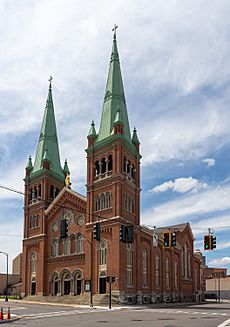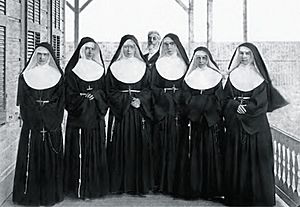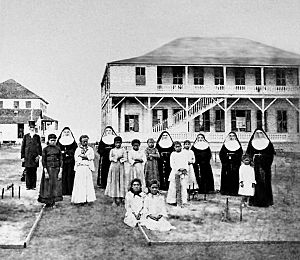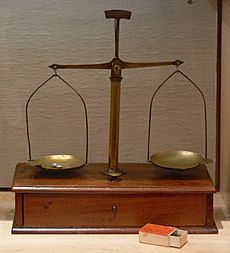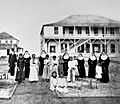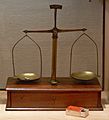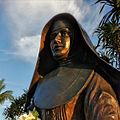Marianne Cope facts for kids
Quick facts for kids SaintMarianne Cope TOSF |
|
|---|---|
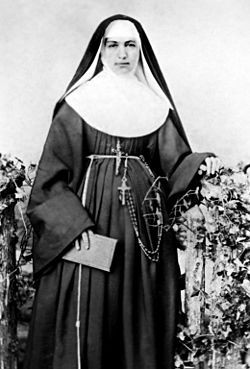
Marianne Cope shortly before her departure for Hawaii (1883)
|
|
| Virgin | |
| Born | Barbara Koob January 23, 1838 Heppenheim, Grand Duchy of Hesse |
| Died | August 9, 1918 (aged 80) Kalaupapa, Hawaiʻi |
| Resting place | Cathedral Basilica of Our Lady of Peace, Honolulu, Hawaii |
| Venerated in | Roman Catholic Church, Episcopal Church |
| Beatified | May 14, 2005, Saint Peter's Basilica by Pope Benedict XVI |
| Canonized | October 21, 2012, Vatican City by Pope Benedict XVI |
| Major shrine | Saint Marianne Cope Shrine & Museum 601 N. Townsend St. Syracuse, New York, U.S. |
| Feast | January 23 (Roman Catholic Church) April 15 (Episcopal Church (United States)) |
| Patronage | Lepers, outcasts, those with HIV/AIDS, Hawaiʻi. |
Marianne Cope, also known as Saint Marianne of Molokaʻi, was a kind and brave religious sister. She was born in Germany on January 23, 1838, and later moved to America. She was part of the Sisters of St Francis of Syracuse, New York.
Marianne helped start St. Joseph's Hospital in Syracuse, which was one of the first 50 general hospitals in the United States. In 1883, she traveled to Hawaiʻi with six other sisters. Their mission was to care for people suffering from leprosy on the island of Molokaʻi. She also helped improve medical care in Hawaiʻi. Even though she worked closely with patients for many years, Marianne never caught the disease herself.
In 2005, Pope Benedict XVI declared Marianne Cope "blessed" (this is called beatification). On October 21, 2012, the same Pope declared her a Saint. She is the 11th person from what is now the United States to become a saint in the Catholic Church.
Contents
Life of Saint Marianne Cope
Early Life and Calling
Marianne Cope was born Barbara Koob in Heppenheim, Germany, on January 23, 1838. Her family moved to the United States the next year and settled in Utica, New York. She went to school at St. Joseph's Parish.
When she was in eighth grade, her father became disabled. As the oldest child, Barbara left school to work in a textile factory. She helped support her family. In the 1850s, she and her family became American citizens.
Barbara received her First Holy Communion and Confirmation at Historic Old St. Johns Church in Utica, New York.
After her father passed away in 1862, Barbara decided to follow her dream of becoming a religious sister. She joined the Sisters of the Third Order Regular of Saint Francis in Syracuse, New York. After a year of training, she became a Franciscan Sister and took the new name Marianne. She first worked as a teacher and then as a principal in schools for German-speaking immigrants.
By 1870, Sister Marianne was part of her religious group's governing council. She helped create the first two Catholic hospitals in Central New York. These hospitals were open to everyone, no matter their race or religion. She was chosen to lead St. Joseph's Hospital, the first public hospital in Syracuse, from 1870 to 1877.
As a hospital leader, Sister Marianne worked with the College of Medicine at Syracuse University. She allowed their students to treat patients in her hospital for their medical training. She made sure that patients had the right to refuse care from students. These experiences helped her prepare for her special work later on.
Journey to Hawaii
In 1883, Sister Marianne was the leader of her group of sisters. She received a special request from King Kalākaua of Hawaii. He asked for help to care for people suffering from leprosy. More than 50 other religious groups had already said no because leprosy was thought to be very contagious.
Sister Marianne and six other Sisters left Syracuse and sailed to Honolulu, arriving on November 8, 1883. Their job was to manage the Kakaʻako Branch Hospital on Oʻahu. This hospital was a place where patients from all over the islands were gathered. Those with more serious cases were sent to the settlement on Molokaʻi at Kalawao, and later at Kalaupapa.
The next year, Sister Marianne opened Malulani Hospital on Maui, which was the first general hospital on that island. Soon after, she was called back to the hospital in Oahu. She found that the government-appointed manager at the Kakaako Branch Hospital was mistreating the leprosy patients. She told the government that either the manager had to be removed, or the Sisters would go back to Syracuse. She was then put in charge of the hospital.
Two years later, the king honored Sister Marianne with the Cross of a Companion of the Royal Order of Kapiolani. This was for her dedicated care of his people. In November 1885, Sister Marianne opened the Kapiolani Home. This home, supported by the government, provided a safe place for homeless girls whose parents had leprosy. It was on the hospital grounds because only the Sisters were willing to care for children so closely connected to the disease.
In 1887, a new government took over. They stopped forcing leprosy patients to go to Molokai and closed the special hospital in Oahu. A year later, the authorities asked Sister Marianne to create a new home for women and girls on the Kalaupapa peninsula of Molokai. She agreed, even though she knew it might mean she would never return to New York. She said, "We will cheerfully accept the work…"
Work on Molokai
In November 1888, Sister Marianne moved to Kalaupapa. She cared for the dying Father Damien, who was already famous for his work in the leper colony. She took over his responsibilities. She had met him shortly after she arrived in Hawaii.
When Father Damien died on April 15, 1889, the government officially put Sister Marianne in charge of caring for the boys of Kalaupapa, along with the women and girls she was already helping. A rich local businessman, Henry Perrine Baldwin, gave money for a new home. Sister Marianne and two other Sisters, Sister Leopoldina Burns and Sister Vincentia McCormick, opened a new school for girls, named in Baldwin's honor. Later, a group of Religious Brothers came to care for the boys. After four Brothers of the Sacred Heart arrived in 1895, Sister Marianne moved the Sisters to the Bishop Home for women and girls with leprosy.
Death
Sister Marianne Cope passed away peacefully on August 9, 1918. She was buried at the Bishop Home. In 2005, her remains were moved to Syracuse. In 2014, her remains were returned to Honolulu and are now in the Cathedral Basilica of Our Lady of Peace.
Legacy and Honors
- 1927 — Saint Francis Hospital was founded in Honolulu in her memory. It was a community hospital that also trained nurses to work with Hansen's disease patients.
- 1957 — St. Francis opened the Child Development Center in Honolulu.
- 1962 — St. Francis Home Care Services was started, offering home health care in Hawaii.
- 2005 — She was inducted into the National Women's Hall of Fame.
- The Saint Francis School was founded in Sister Marianne's honor in 1924.
The community that Sister Marianne started on Molokai still helps the few patients who have Hansen's disease. The Franciscan Sisters also work in schools and help people throughout the Hawaiian Islands.
Becoming Blessed (Beatification)
In 1993, a woman named Katherine Dehlia Mahoney said she was healed from a serious illness after praying to Marianne Cope. On October 24, 2003, the Congregation for the Causes of Saints said that Sister Marianne had lived a "heroically virtuous" life. On April 19, 2004, Pope John Paul II declared her "Venerable." On December 20, 2004, Pope John Paul II said that Katherine's healing was a miracle that happened because of Sister Marianne's prayers.
On May 14, 2005, Sister Marianne Cope was declared "Blessed" (this is called beatification) in Vatican City by Pope Benedict XVI. This was Pope Benedict XVI's first beatification ceremony. More than 100 people from Hawaiʻi attended the ceremony, along with 300 members of Sister Marianne's religious group from Syracuse. Her feast day was set for January 23.
After the announcement of her beatification, Sister Marianne's remains were moved to the main house of her religious group in Syracuse in January 2005. A special place was created to honor her. By 2009, a marble tomb was built in the chapel, and her remains were placed there on her feast day, January 23.
In 2007, a statue of her was put up at St. Joseph's Church in her hometown of Utica, where she went to school as a child.
Becoming a Saint (Canonization)
On December 6, 2011, the Congregation for the Causes of Saints found that a second miracle could also be linked to Sister Marianne's prayers. On December 19, 2011, Pope Benedict XVI approved this finding. She was then declared a Saint on October 21, 2012. A special item (a relic) from her church was brought to Honolulu.
Sister Marianne Cope is the second person to become a saint who served in the Hawaiian Islands, after Father Damien. She was the first person Pope Benedict XVI declared "Blessed" and the last person he declared a "Saint." In 2014, the church announced that Saint Marianne's remains would be moved again to the Cathedral Basilica of Our Lady of Peace in Honolulu. This location is easier for people to visit than the Kalaupapa National Historical Park on Molokaʻi.
Honored by Other Churches
Sister Marianne Cope is honored along with Saint Damien of Molokaʻi in the Episcopal Church (USA). Their shared feast day is celebrated on April 15.
In Arts and Media
The film Molokai: The Story of Father Damien (1999) was directed by Paul Cox. Sister Marianne Cope was played by actress Alice Krige.
See also
 In Spanish: Mariana Cope para niños
In Spanish: Mariana Cope para niños
- List of American saints and beatified people
Images for kids


